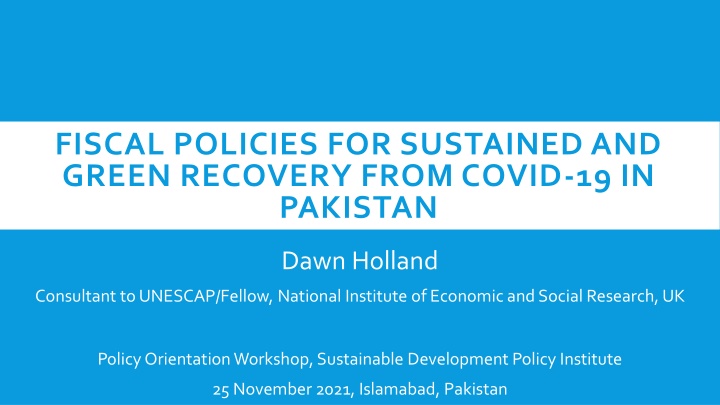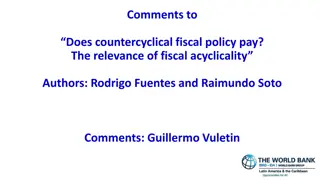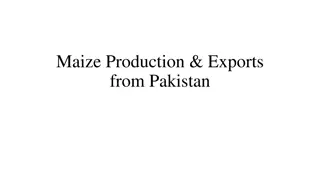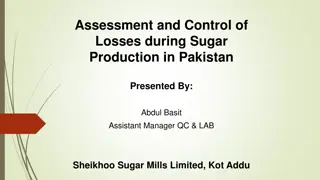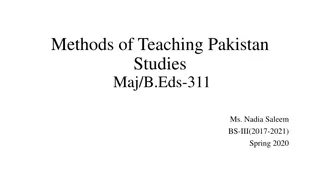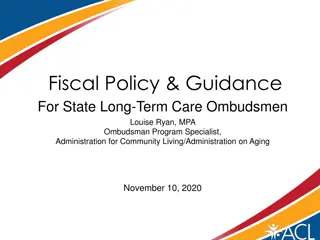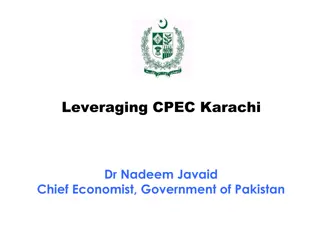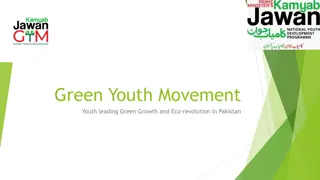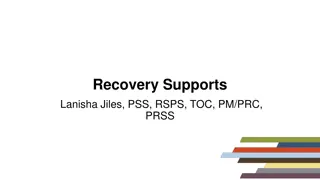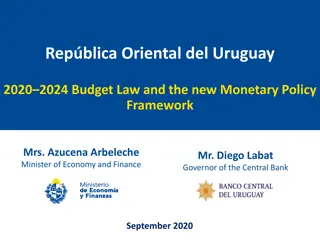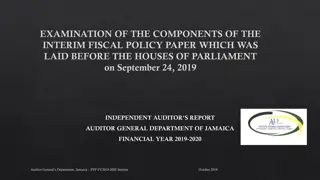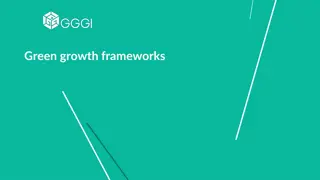Fiscal Policies for Sustained and Green Recovery in Pakistan
This presentation discusses fiscal policies for sustainable and green recovery from COVID-19 in Pakistan, focusing on the ESCAP macroeconomic model and its application to economic recovery packages for the Asia-Pacific region. The ESCAP model is detailed, with insights on key actors and features, offering a comprehensive view of economic dynamics for informed policy decisions.
Download Presentation

Please find below an Image/Link to download the presentation.
The content on the website is provided AS IS for your information and personal use only. It may not be sold, licensed, or shared on other websites without obtaining consent from the author.If you encounter any issues during the download, it is possible that the publisher has removed the file from their server.
You are allowed to download the files provided on this website for personal or commercial use, subject to the condition that they are used lawfully. All files are the property of their respective owners.
The content on the website is provided AS IS for your information and personal use only. It may not be sold, licensed, or shared on other websites without obtaining consent from the author.
E N D
Presentation Transcript
FISCAL POLICIES FOR SUSTAINED AND GREEN RECOVERY FROM COVID-19 IN PAKISTAN Dawn Holland Consultant to UNESCAP/Fellow, National Institute of Economic and Social Research, UK Policy Orientation Workshop, Sustainable Development Policy Institute 25 November 2021, Islamabad, Pakistan
INTRODUCTION TO ESCAP MACROECONOMIC MODEL FOR PAKISTAN
WHAT IS A MACROECONOMIC MODEL? A set of interacting equations that describes key elements of the complex interactions between major macroeconomic actors and variables Even complex models are inevitably a gross oversimplification of reality Models will only deliver a pre-programmed response 3
THE ESCAP MACROECONOMIC MODEL Developed by the Macroeconomic Policy and Analysis Section at ESCAP to support the design of economic recovery packages for countries in the Asia and Pacific region A complete global model: 46 individual full country models for the Asia and Pacific region, including Pakistan Smaller models of 9 key trading partners and 4 major regions Models are linked together via trade, remittances, financial and energy markets Runs in EViews, with most behavioural relationships specified in an error- correction framework to distinguish short-term and long-term dynamics
THE ESCAP MACROECONOMIC MODEL What style of model? Structural econometric model Common theoretical structure applied to all country models Country-specific parameters are econometrically estimated or calibrated Designed primarily for scenario analysis rather than forecasting Each country model has about 100 equations Founded on a standard macroeconomic framework, with additional channels to capture key social and environmental variables Can be applied to a wide range of policy questions plus stress testing and debt sustainability analysis
KEY ACTORS AND FEATURES OF THE MODEL Poverty: Depends on income and post-tax inequality Households: - Consume - Save - Supply labour Emissions: Depend on output, efficiency of production, and the energy mix Firms: - Produce output - Hire labour - Invest Global linkages: Via trade, remittances, financial markets, emissions and energy markets Government: - Tax - Spend - Monetary policy
ECONOMIC INDICATORS: MODELLING GDP GDP is driven by demand in the short-term Sum of consumption, investment, net trade: GDP is driven by supply in the long-term Labour, capital, energy, technology, climate damage:
AGGREGATE DEMAND: PRIVATE CONSUMPTION Household consumption (PCR) per capita (POPT) depends on: Real personal disposable income (RPDI) Financial inclusion (FINC) Inflation surprise (INFL INFLe)
AGGREGATE DEMAND: PRIVATE INVESTMENT Private sector investment (IPR) depends on: Potential output (YFT) User cost of capital (USER) Financial inclusion (FINC) Gross domestic income (GDI) captures terms-of- trade shocks Lagged dependent variable allows for persistence to capture cyclical nature of investment
AGGREGATE DEMAND: PUBLIC INVESTMENT AND CONSUMPTION Policy variables, that are disaggregated into: Spending on health (EXPH) Spending on environmental protection (EXPE) Other government consumption (OGC) Other government investment (OGI) Public investment cumulates onto capital stock (K)
AGGREGATE DEMAND: EXPORTS Exports (XTR) depend on: Country-specific external demand (WDR) Relative (non-commodity) export prices (XTDNO$/CXUD) External demand and global export prices are derived from a global trade matrix to capture bilateral sensitivities between countries
AGGREGATE DEMAND: IMPORTS Imports (MTR) depend on: Demand (PCR+ITR+GCR+XTR) Speed of pass-through allowed to differ across components of domestic demand An output gap (YFT/YER) Relative price of imported goods Oil imports
AGGREGATE SUPPLY: POTENTIAL OUTPUT An underlying production function describes the potential output of the economy: ??? = ? ?,?,?,?,??????? Capital inputis determined by the accumulated investment, with a rate of depreciation that depends on global CO2 emissions Potential labourinput depends on demographics and labour force participation
AGGREGATE SUPPLY: POTENTIAL OUTPUT Total energy input depends on output, energy prices and energy efficiency; the energy mix depends on relative prices of oil, gas, coal and renewables Trend productivity growth has an endogenous relationship with health expenditure; inequality; air pollution and world trade Climate damages are exogenous, but in scenarios can be linked to spending on climate resilient infrastructure
RECONCILING SUPPLY AND DEMAND Deviations of actual output from potential output set in motion adjustment processes that bring the economy back to potential in the long run. For example, the gap between supply and demand ( output gap ) feeds back through prices
INFLATION AND PRICES In addition to the balance of demand and supply, tax policy, global commodity prices and other imported prices determine inflation. Higher prices: Slows consumption Worsens net trade balance Both reduce GDP to bring in line with potential
GOVERNMENT SECTOR The model has an expanded fiscal module, to allow a range of policy scenarios to be studied Fiscal policy channels include: Spending on social protection Spending on health Spending on environmental protection Fossil fuel subsidies Carbon tax Income tax Corporate tax Indirect tax Taxes on international transactions Commodity revenue The fiscal deficit flows onto the government debt stock, and debt service payments flow back onto the fiscal balance
GOVERNMENT BORROWING PREMIUM The fiscal deficit flows onto the government debt stock, and debt service payments flow back onto the fiscal balance Deficit deteriorates A country risk premium is linked to the ratio of government debt to GDP Debt servicing costs rise Debt rises Potential risks to solvency when deficit is allowed to rise Risk premium squeezes out investment, puts pressure on the exchange rate and pushes up inflation Risk premium rises
GOVERNMENT SECTOR A fiscal rule can be imposed to avoid Ponzi games , so that debt cannot continue to rise without bounds. When the rule is active, income and corporate tax rates rise to revert the deficit to a specified target The rule can be turned off to assess where debt is headed if a policy package is financed fully via an increase in debt
EMISSIONS AND AIR POLLUTION CO2 emissions depend on the quantity of coal, oil and gas consumed: ??2 = 96 ????? + 57 ???? + 67.4 ???? CO2 emissions feed into government revenue via carbon taxes and subsidies, and global emissions impact the rate of depreciation Air pollution (PM2.5) depends on the shares of coal and oil in total energy consumption, and feeds back into trend productivity growth to reflect the relationship between pollution and health
POVERTY Poverty model is based on an assumption that income approximately follows a lognormal distribution We calculate the cumulative density function of log income, evaluated at the poverty benchmarks of $1.90/day and $5.50/day. Requires an estimate of inequality (GINI Coefficint) and mean income (approximated to track consumption per capita)
INEQUALITY The standard deviation of log income, needed to calibrate poverty, is derived from the GINI coefficient based on disposable income The GINI depends on a relative redistribution parameter, which is linked to government spending on social protection, and a financial inclusion index, which we proxy with the share of the population with a bank account In addition to poverty, the GINI feeds into potential output
ESCAP MACROECONOMIC MODEL APPLIED TO ILLUSTRATE POLICY RECOMMENDATIONS
WHAT IS A SCENARIO? A scenario is developed relative to a baseline set of assumptions. The scenario asks, what if [some assumption] turns out different than assumed? For example, we can consider new government spending programmes, an unexpected rise in oil price, a drop in world trade, policies to encourage women to seek employment, etc
SCENARIO 1: INCREASED SOCIAL SPENDING AND EXPANDED SOCIAL PROTECTION Public Fiscal balance consumption Fiscal balance Public Social protection spending (2.14% of GDP) Public/Private investment Spending on education (5.7% of GDP) consumption Real personal disposable income Income distribution and inequality Spending on health (5.4% of GDP) Public/Private investment Inequality Trend Trend productivity productivity Government debt Potential output Poverty GDP
SCENARIO 1: INCREASED SOCIAL SPENDING AND EXPANDED SOCIAL PROTECTION Figure 19. Impact of Spending of Social Protection, Health and Education, in the absence of financing constraints, on Key Indicators (%) Impact on GDP (% difference from base) Impact on Government debt (% of GDP) Impact on Inflation (%age point diff from base) 16 70 1.2 1.0 14 60 0.8 12 0.6 50 0.4 10 40 0.2 8 0.0 30 6 -0.2 20 -0.4 4 -0.6 10 2 -0.8 0 0 -1.0 2022 2023 2024 2025 2026 2027 2028 2029 2030 2022 2023 2024 2025 2026 2027 2028 2029 2030 2022 2023 2024 2025 2026 2027 2028 2029 2030 Impact on Unemployment rate (%age point diff. from base) Impact on Poverty rate (%age point diff. from base) Impact on Gini Coefficient (%age point diff. from base) 0.0 0 0.0 -0.2 -1 -0.5 -0.4 -2 -0.6 -3 -1.0 -0.8 -4 -1.0 -1.5 -5 -1.2 -6 -1.4 -2.0 -7 -1.6 -2.5 -8 -1.8 2022 2023 2024 2025 2026 2027 2028 2029 2030 2022 2023 2024 2025 2026 2027 2028 2029 2030 2022 2023 2024 2025 2026 2027 2028 2029 2030 Source: UN ESCAP Macroeconomic Model Scenarios
SCENARIO 1: INCREASED SOCIAL SPENDING AND EXPANDED SOCIAL PROTECTION FINANCED Figure 20. Impact of Spending of Social Protection, Health and Education, Financed and Unfinanced scenarios, on Key Indicators (%) Impact on Government debt (% of GDP) Impact on Inflation (%age point diff from base) Impact on GDP (% difference from base) 70 1.5 16 14 60 1.0 12 50 0.5 10 40 0.0 8 30 6 -0.5 20 4 -1.0 10 2 -1.5 0 0 2022 2023 2024 2025 2026 2027 2028 2029 2030 2022 2023 2024 2025 2026 2027 2028 2029 2030 2022 2023 2024 2025 2026 2027 2028 2029 2030 Unfinanced Financed Unfinanced Financed Unfinanced Financed Impact on Unemployment rate (%age point diff. from base) Impact on Poverty rate (%age point diff. from base) Impact on Gini Coefficient (%age point diff. from base) 0.0 0 0.0 -1 -0.5 -2 -0.5 -3 -1.0 -4 -1.0 -1.5 -5 -6 -1.5 -2.0 -7 -2.5 -8 -2.0 2022 2023 2024 2025 2026 2027 2028 2029 2030 2022 2023 2024 2025 2026 2027 2028 2029 2030 2022 2023 2024 2025 2026 2027 2028 2029 2030 Unfinanced Financed Unfinanced Financed Unfinanced Financed
SCENARIO 2: INCREASED FEMALE LABOUR FORCE PARTICIPATION Potential labour input Potential output Rise in participation (10 percentage points over 10 years) Inequality Unemployment rate Government debt Poverty GDP Inflation
SCENARIO 2: INCREASED FEMALE LABOUR FORCE PARTICIPATION Figure 21. Impact of Rise in Female Labour Force Participation on Key Indicators (%) Impact on GDP (% difference from base) Impact on Inflation (%age point diff from base) Impact on Government debt (% of GDP) 7 0.15 1 0.10 6 0 0.05 0.00 5 -1 -0.05 4 -0.10 -2 -0.15 3 -0.20 -3 2 -0.25 -0.30 -4 1 -0.35 -5 0 -0.40 2028 2046 2022 2024 2026 2030 2032 2034 2036 2038 2040 2042 2044 2048 2050 2026 2036 2046 2022 2024 2028 2030 2032 2034 2038 2040 2042 2044 2048 2050 2034 2050 2022 2024 2026 2028 2030 2032 2036 2038 2040 2042 2044 2046 2048 Impact on Gini Coefficient (%age point diff. from base) Impact on Poverty rate (%age point diff. from base) Impact on Unemployment rate (%age point diff. from base) 0.0 0.0 2.0 -0.5 -0.1 1.5 -1.0 -0.2 -1.5 1.0 -0.3 -2.0 0.5 -2.5 -0.4 -3.0 0.0 -0.5 -3.5 -0.6 -4.0 -0.5 2028 2022 2024 2026 2030 2032 2034 2036 2038 2040 2042 2044 2046 2048 2050 2024 2022 2026 2028 2030 2032 2034 2036 2038 2040 2042 2044 2046 2048 2050 2044 2022 2024 2026 2028 2030 2032 2034 2036 2038 2040 2042 2046 2048 2050
SCENARIO 3: INVEST IN A GREEN RECOVERY Fiscal balance Energy mix Emissions and pollution Invest in green transport infrastructu re (1.2% of GDP) Invest in green energy (30% share of renewables) Eliminate fossil fuel subsidies (75%) Energy mix Energy efficiency Inflation Productivity Employment Cost of capital Government debt Potential output Emissions GDP
SCENARIO 3: INVEST IN A GREEN RECOVERY Figure 22. Impact of Green Recovery Programme on Key Indicators (%) Impact on GDP (% difference from base) Impact on Government debt (% of GDP) Impact on Unemployment rate (%age point diff. from base) 0.00 2 0.0 1.8 -0.5 -0.05 1.6 -1.0 -0.10 1.4 -1.5 1.2 -2.0 -0.15 1 -2.5 -0.20 0.8 -3.0 0.6 -3.5 -0.25 0.4 -4.0 -0.30 0.2 -4.5 -0.35 0 -5.0 2034 2050 2022 2024 2026 2028 2030 2032 2036 2038 2040 2042 2044 2046 2048 2032 2044 2022 2024 2026 2028 2030 2034 2036 2038 2040 2042 2046 2048 2050 2028 2022 2024 2026 2030 2032 2034 2036 2038 2040 2042 2044 2046 2048 2050 Impact on pollution (PM2.5) (% difference from base) Impact on CO2 emissions (% difference from base) Impact on Poverty rate (%age point diff. from base) 0 0 0.0 -1 -2 -0.1 -2 -4 -3 -0.2 -6 -4 -0.3 -8 -5 -10 -0.4 -6 -12 -7 -0.5 -14 -8 -0.6 -9 -16 -10 -18 -0.7 2024 2050 2022 2026 2028 2030 2032 2034 2036 2038 2040 2042 2044 2046 2048 2028 2046 2022 2024 2026 2030 2032 2034 2036 2038 2040 2042 2044 2048 2050 2024 2022 2026 2028 2030 2032 2034 2036 2038 2040 2042 2044 2046 2048 2050
SCENARIO 4: DIGITAL TRANSFORMATION UNIVERSAL DIGITAL ACCESS Public investment Potential output Private investment ICT investment (2.2% of GDP) Trend productivity Inequality Financial inclusion Government debt Potential output Poverty GDP
SCENARIO 4: DIGITAL TRANSFORMATION Figure 23. Impact of Digital Transformation Programme on Key Indicators (%) Impact on Inflation (%age point diff from base) Impact on GDP (% difference from base) Impact on Government debt (% of GDP) 7 0.15 5.0 4.5 0.10 6 4.0 0.05 5 3.5 0.00 3.0 4 -0.05 2.5 3 2.0 -0.10 1.5 2 -0.15 1.0 1 -0.20 0.5 0 -0.25 0.0 2026 2036 2046 2022 2024 2028 2030 2032 2034 2038 2040 2042 2044 2048 2050 2034 2050 2030 2042 2022 2024 2026 2028 2030 2032 2036 2038 2040 2042 2044 2046 2048 2022 2024 2026 2028 2032 2034 2036 2038 2040 2044 2046 2048 2050 Impact on CO2 emissions (% difference from base) Impact on Unemployment rate (%age point diff. from base) Impact on Poverty rate (%age point diff. from base) 0.00 7 0.0 -0.10 6 -0.5 -0.20 5 -1.0 -0.30 -0.40 4 -1.5 -0.50 3 -2.0 -0.60 -0.70 2 -2.5 -0.80 1 -3.0 -0.90 0 -1.00 -3.5 2022 2024 2026 2028 2030 2032 2034 2036 2038 2040 2042 2044 2046 2048 2050 2034 2050 2022 2024 2026 2028 2030 2032 2036 2038 2040 2042 2044 2046 2048 2024 2022 2026 2028 2030 2032 2034 2036 2038 2040 2042 2044 2046 2048 2050
